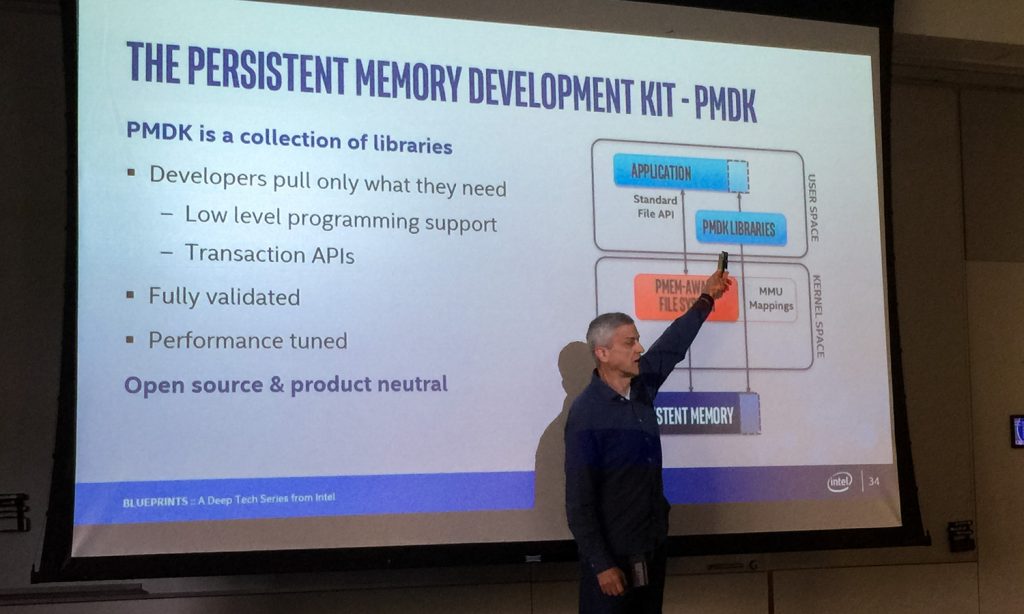Intel เปิดตัว Optane memory ที่มาในแบบสล๊อต DDR4 DIMM slots ความจุ 512GB
| Share | Tweet |
Intel เปิดตัว Optane memory ที่มาในแบบสล๊อต DDR4 DIMM slots ความจุ 512GB

อินเทลผู้ผลิตซีพียูรายใหญ่และอุปกรณ์พีซีต่างๆประกาศเปิดตัว Optane memory ที่มาในแบบสล๊อต DDR4 DIMM slots กับความจุสูงถึง 512GB ที่ใช้เทคโนโลยี 3D XPoint technology มีขนาดความจุตั้งแต่ 128, 256 และ 512 GB. โดยการออกแบบนั้นจะคล้ายๆกับแรม DDR4 slots ซึ่งทั้งโมดูลนั้นรองรับการทำงานของซีพียู Xeon รุ่นใหม่ล่าสุดที่เป็นกลุ่มของเซิพเวอร์ โดย Intel Optane memory DIMMs นั้นจะมีประสิทธิภาพความแรงกว่าบรรดาหน่วยเก็บความจุทั่วๆไปเป็นการรวมเอาเมมโมรี่กับแรมทำงานร่วมกัน storage tier โดยจะวางจำหน่ายจริงในปี 2019

Intel Optane DC Persistent Memory Announced: Now Sampling, Up to 512GB DIMMS
Today Intel held a memory and storage event to announce their latest product and we were there to get the inside scoop on what that is, Optane DC Persistent Memory. Optane DC Persistent Memory is a new storage tier that puts Intel Optane memory onto a DIMM to get it closer to the CPU and this has opened up all kinds of new possibilities.

Putting storage on a DIMM isn’t new. NVDIMMs have been around for a few years now and they are becoming the bridge between DRAM and the traditional storage tiers. But, before Intel Optane, the fastest storage media has been NAND. While NAND based SSDs have been the bread and butter for our content, it does have its drawbacks, especially for those who are pushing the boundaries of application performance. NAND based NVDIMMs just aren’t enough. Endurance is too low and performance isn’t anywhere near DRAM.
With the announcement of Intel Optane DC persistent memory, Intel takes on these challenges and more. We all know Intel Optane is fast. There is no read/write/modify garbage collection process, the memory is bit addressable, it delivers speed with much lower latency than NAND, and unlike DRAM data doesn’t vanish into thin air when the power goes out. This is great for applications that have large, latency sensitive data sets and from what we heard from the executives from multiple database companies as well as from CERN, Intel Optane DC Persistent Memory is enabling them to do much more for less money. In some of their R&D, they are finding that because these Intel Optane DC Persistent Memory modules are so fast as a cache you don’t need as much capacity as they have needed with current NVMe SSDs. You can utilize a smaller cache and gain much more performance, and thus this helps to lower cost per transaction.

Lisa Spelman, VP & GM of Intel Xeon Products and Data Center Marketing states that “For example, for planned restarts of a NoSQL in-memory database using Aerospike* Hybrid Memory Architecture, Intel Optane DC persistent memory provides a minutes-to-seconds restart speedup compared to DRAM-only cold restart.” (16.9s vs 24min was demo’d to us during the event). Another example she gave us was that, “On memory-intensive workloads such as Redis IMDB server, Intel’s persistent memory enables higher memory capacities, delivering more server instances at the same service level agreement (SLA) performance when compared to a system configured with just DRAM.”
But, while these examples are very impressive, the memory itself has opened up new challenges. With a new storage tier, how are developers going to interact with it? Well, Intel has you covered. In addition to the release of the product itself, Intel has also created a software development environment where software developers can remote into systems with their Intel Optane DC persistent memory develop and test on this new technology. Intel calls it their “Intel Builders Construction Zone.” Intel is trying to bring their technology to the masses and all the software behind it is open source. They are currently focusing on database utilization, but are looking for new ways for end users to utilize their product. More info on how to dive in here.
Currently, a 128GB DDR4 DIMM costs around $4K, while Intel has not yet disclosed their pricing model, we can expect new Optane DC DIMMs will come in at a lower price point, especially when looking at TCO. These new DIMMs are DDR4 pin compatible and feature AES 256-bit hardware encryption with no performance loss. Capacities of 128GB, 256GB, and 512GB will be available and Intel is sampling today. They announced that they will be shipping for revenue to select customers later this year, with broad availability in 2019.
Some additional notes about this new product and technology:
-Compatible with Intel’s next-gen Cascade Lake Xeon CPUs
-Intel couldn’t disclose any information on pricing, endurance, power consumption or hard performance numbers. But, they did mention they operate at standard DDR4 speeds.
-This new memory also cuts out need for file system and thus lowers latency even more
-Still utilizes 1st gen Optane
-Codename: Apache Pass
-Currently can utilize RDMA, but they are working on Persistent Memory Over Fabric (PMOF) to further optimize replication
ที่มา http://www.thessdreview.com/
 EN
EN










